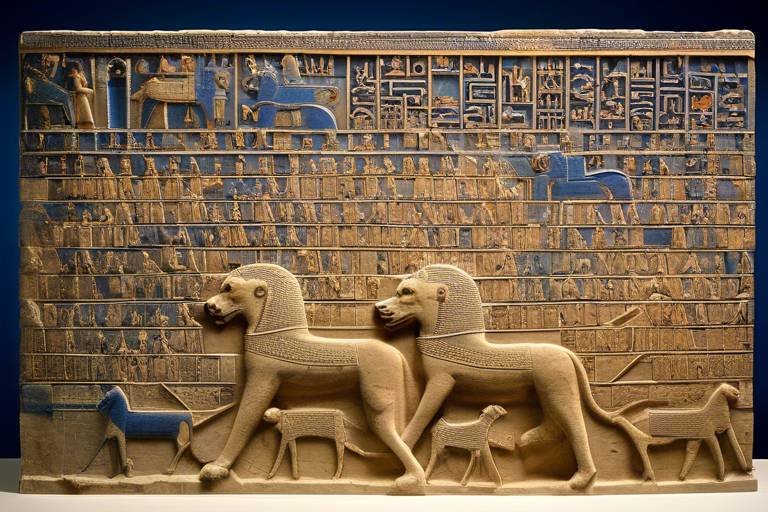The Secrets of Ancient Babylon - The Ishtar Gate
Deep within the annals of ancient history lies a marvel that continues to captivate and intrigue us to this day - the Ishtar Gate of Babylon. This monumental structure stands as a testament to the power and grandeur of the ancient Babylonian civilization, serving as a symbol of their cultural richness and architectural prowess.
The Ishtar Gate, constructed during the reign of King Nebuchadnezzar II in the 6th century BC, was not just a mere entrance to the city of Babylon. It was a masterpiece of art and engineering, adorned with vibrant glazed bricks depicting mythical creatures and symbols of gods and goddesses.
As you stand before the reconstructed Ishtar Gate at the Pergamon Museum in Berlin, you can't help but marvel at the intricate details and the sheer magnitude of this ancient wonder. Its blue hues and intricate designs transport you back in time, offering a glimpse into the opulence and sophistication of Babylonian society.
Uncover the secrets of the Ishtar Gate, a gateway to a world long gone but not forgotten. Explore its history, symbolism, and cultural significance, and let yourself be transported to a time when Babylon reigned supreme in the ancient world.

History of Babylon
The history of Babylon is a tapestry woven with threads of power, culture, and innovation. Situated in the fertile lands of Mesopotamia, Babylon rose to prominence as a mighty city-state in ancient times. Its strategic location along the Euphrates River allowed it to flourish as a center of trade and culture, attracting merchants, scholars, and artisans from far and wide.
The city of Babylon was not only a hub of commerce but also a cradle of civilization, where monumental achievements in architecture, astronomy, and literature were made. The Hanging Gardens of Babylon, one of the Seven Wonders of the Ancient World, stood as a testament to the ingenuity and grandeur of Babylonian engineering.
Under the rule of legendary kings such as Hammurabi and Nebuchadnezzar II, Babylon reached its zenith as a powerful empire, extending its influence across Mesopotamia and beyond. The Code of Hammurabi, a comprehensive legal code inscribed on a stele, reflected the city's commitment to justice and order.
Despite facing periods of conquest and decline, Babylon's legacy endured through the ages, leaving an indelible mark on the annals of history. Its towering ziggurats, bustling markets, and vibrant temples painted a vivid picture of a city that once stood as a beacon of civilization in the ancient world.

Ishtar Gate Construction
Exploring the historical significance and architectural marvel of the Ishtar Gate, a key symbol of ancient Babylonian culture and power. Learn about its construction, purpose, and cultural impact on the ancient world.
The construction of the Ishtar Gate was a monumental feat that showcased the advanced engineering skills of the ancient Babylonians. Built during the reign of King Nebuchadnezzar II in the 6th century BC, the gate was part of the larger city walls of Babylon, serving as the main entrance to the city.
The gate was constructed using a combination of mud brick and glazed bricks, with vibrant colors such as blue, yellow, and white creating intricate patterns and designs. The glazed bricks were baked in kilns to achieve a durable and decorative finish, adding to the gate's grandeur.
Skilled craftsmen and artisans meticulously crafted the Ishtar Gate, incorporating intricate details and symbolic motifs. The gate was adorned with images of dragons, bulls, and lions, symbolizing the power and protection of the Babylonian gods.
The construction process involved precise planning and coordination, with each brick carefully placed to form the elaborate designs that adorned the gate. The sheer size and complexity of the Ishtar Gate's construction highlighted the wealth and sophistication of ancient Babylonian society.
Archaeological excavations have revealed the remains of the Ishtar Gate, providing valuable insights into the construction techniques and artistic achievements of the Babylonians. The discovery of these ancient ruins has allowed historians and archaeologists to piece together the story of this magnificent structure.
In modern times, the reconstruction of the Ishtar Gate at the Pergamon Museum in Berlin stands as a testament to the ingenuity and craftsmanship of the ancient Babylonians. Visitors can marvel at the intricate details and vibrant colors of the gate, experiencing a glimpse of the grandeur that once defined the city of Babylon.
1. What was the purpose of the Ishtar Gate in ancient Babylonian society?
2. How did the construction of the Ishtar Gate showcase the artistic and engineering skills of the Babylonians?
3. What materials were used in the construction of the Ishtar Gate?
4. What symbolic motifs and designs adorned the Ishtar Gate?
5. Why is the Ishtar Gate considered a significant archaeological discovery?

Symbolism and Design
The Ishtar Gate, a magnificent structure that once adorned the ancient city of Babylon, is not merely a physical barrier but a gateway to a world of symbolism and design intricacies. As one gazes upon its vibrant glazed brickwork, adorned with depictions of mythological creatures such as dragons and bulls, a sense of awe and wonder washes over them. Each color, each symbol carefully crafted into the gate tells a story of the beliefs and values of the Babylonian people.
The design of the Ishtar Gate is a testament to the artistic prowess of the ancient Babylonians. The intricate patterns and motifs, meticulously laid out in a symphony of colors, serve as a visual feast for the eyes. The gate's grand archway, flanked by towering towers, creates a sense of grandeur and power, reflecting the might and influence of the Babylonian empire. It stands not just as a physical structure but as a work of art, a masterpiece that transcends time and space.
Symbolism permeates every inch of the Ishtar Gate, from the choice of materials to the depictions of mythical beings. The vibrant blue tiles, symbolizing the goddess Ishtar, the gate's namesake, evoke a sense of divinity and protection. The images of lions and dragons, symbols of strength and power, guard the gate, warding off evil spirits and protecting the city within. Each element, each detail carefully chosen to convey a message of strength, prosperity, and divine protection.
As one delves deeper into the symbolism and design of the Ishtar Gate, a world of ancient beliefs and values unfolds before them. The gate not only served as a physical barrier but as a spiritual and cultural symbol, a manifestation of the Babylonians' worldview and beliefs. It stands as a testament to the ingenuity and creativity of a civilization long gone, a reminder of the enduring power of art and architecture to transcend time and space.

Archaeological Discoveries
Archaeological discoveries surrounding the Ishtar Gate have provided invaluable insights into the ancient Babylonian culture and its architectural achievements. Excavations at the site have revealed fragments of the gate's vibrant glazed bricks, showcasing the intricate craftsmanship of the Babylonian artisans. These discoveries have allowed historians and archaeologists to piece together the original design and color scheme of the gate, offering a glimpse into the opulence of ancient Babylonian architecture.
Moreover, the excavation of the Ishtar Gate remains has unearthed various artifacts and inscriptions that shed light on the gate's cultural significance. These findings have provided clues about the gate's role in religious ceremonies and royal processions, highlighting its importance in ancient Babylonian society. The archaeological discoveries have also sparked debates among scholars regarding the gate's symbolic meanings and its connection to Babylonian mythology.

Cultural Significance
Exploring the historical significance and architectural marvel of the Ishtar Gate, a key symbol of ancient Babylonian culture and power. Learn about its construction, purpose, and cultural impact on the ancient world.
Discover the rich history of the city of Babylon, including its rise to prominence, cultural achievements, and influence on Mesopotamian civilization.
Uncover the intricate details of the construction process of the Ishtar Gate, from the materials used to the skilled craftsmanship involved in its creation.
Explore the symbolic significance and elaborate design elements of the Ishtar Gate, including its vibrant glazed brickwork and depictions of mythological creatures.
Learn about the archaeological excavations that unearthed the remains of the Ishtar Gate, shedding light on its historical context and cultural importance.
The Ishtar Gate held immense cultural significance in ancient Babylonian society. It served not only as a grand entrance to the city but also as a symbol of religious and royal power. The gate was dedicated to the goddess Ishtar, the deity of love, fertility, and war, making it a focal point for religious rituals and ceremonies. Its intricate design and vibrant colors were believed to ward off evil spirits and protect the city from harm, showcasing the deep spiritual beliefs of the Babylonians.
Investigate the lasting legacy of the Ishtar Gate on art, architecture, and cultural heritage, influencing later civilizations and inspiring modern interpretations.
Delve into the ongoing efforts to preserve and restore the Ishtar Gate, ensuring that this ancient wonder continues to captivate and inspire future generations.
Plan your visit to see the reconstructed Ishtar Gate at the Pergamon Museum in Berlin, where it stands as a testament to the enduring legacy of ancient Babylon.

Legacy of the Ishtar Gate
The extends far beyond the borders of ancient Babylon, leaving an indelible mark on art, architecture, and cultural heritage for centuries to come. This monumental structure, with its vibrant blue glazed bricks and intricate reliefs of mythological creatures, has inspired awe and admiration in generations of onlookers.
One of the most significant aspects of the Ishtar Gate's legacy is its influence on subsequent artistic and architectural endeavors. The gate's unique design and use of color have served as a source of inspiration for artists and architects throughout history, shaping the visual language of various cultures and civilizations.
Moreover, the Ishtar Gate's depiction of mythological beings and divine symbols has contributed to the development of religious iconography and storytelling traditions. The gate's intricate reliefs not only served a decorative purpose but also conveyed powerful narratives that resonated with ancient Babylonians and continue to captivate modern audiences.
Furthermore, the Ishtar Gate's enduring legacy can be seen in its impact on cultural exchange and cross-cultural interactions. As a symbol of Babylonian power and prestige, the gate played a crucial role in diplomatic relations and trade networks, facilitating the exchange of ideas, goods, and artistic techniques across ancient empires.
In addition to its historical significance, the Ishtar Gate's legacy lives on through ongoing archaeological research and conservation efforts. Scholars and experts continue to study the gate's construction techniques, symbolism, and cultural context, shedding new light on its role in ancient Babylonian society and its broader significance in the ancient world.

Restoration Efforts
Restoration efforts for the Ishtar Gate have been a labor of love and dedication, aiming to preserve this ancient wonder for future generations to admire and study. The meticulous process of restoring the gate involves expert archaeologists, historians, and conservationists working together to ensure the gate's authenticity and historical accuracy. Through careful research and analysis, the original design and color scheme of the gate have been recreated, allowing visitors to experience the grandeur of ancient Babylon firsthand.
One of the key challenges faced during the restoration efforts was the delicate nature of the materials used in the construction of the Ishtar Gate. The glazed bricks and intricate reliefs required special care and attention to prevent damage during the restoration process. Conservationists employed advanced techniques and technology to stabilize the structure and prevent further deterioration, ensuring that the Ishtar Gate remains intact for future generations to appreciate.
The restoration of the Ishtar Gate also serves as a testament to the enduring legacy of ancient Babylonian culture and craftsmanship. By preserving this architectural marvel, historians and archaeologists can continue to unravel the mysteries of the past and gain valuable insights into the artistic and engineering achievements of the Babylonian civilization. The reconstructed Ishtar Gate stands as a symbol of cultural heritage and a reminder of the greatness of ancient civilizations.

Visiting the Ishtar Gate
When , prepare to be transported back in time to the ancient city of Babylon, where this magnificent structure once stood as a symbol of power and grandeur. As you approach the reconstructed gate at the Pergamon Museum in Berlin, marvel at the intricate details and vibrant colors that have been meticulously restored to showcase the gate's former glory.
Step through the towering Ishtar Gate and immerse yourself in the world of ancient Mesopotamia, where mythological creatures and symbolic motifs adorn the walls, telling stories of gods and goddesses revered by the Babylonians. The gate's design, with its alternating rows of dragons and bulls, is a testament to the skilled craftsmanship and artistic prowess of the ancient builders.
Take a moment to appreciate the cultural significance of the Ishtar Gate, which served not only as a grand entrance to the city but also as a sacred space where religious ceremonies and royal processions took place. The gate's imposing presence would have struck awe into the hearts of all who passed through, reinforcing the power and authority of Babylonian rulers.
As you wander through the museum and gaze upon the reconstructed Ishtar Gate, consider the legacy that this ancient marvel has left on the world. Its influence can be seen in the art and architecture of later civilizations, echoing through history to inspire modern interpretations of beauty and grandeur.
Before you leave, take a moment to reflect on the restoration efforts that have preserved the Ishtar Gate for future generations to admire. The dedication and expertise of archaeologists and historians have ensured that this architectural wonder continues to captivate and educate visitors from around the globe.
Frequently Asked Questions
- What is the historical significance of the Ishtar Gate?
The Ishtar Gate holds immense historical significance as a symbol of ancient Babylonian culture and power. It served as the main entrance to the city of Babylon and was dedicated to the goddess Ishtar, showcasing the wealth and artistic prowess of the Babylonian empire.
- How was the Ishtar Gate constructed?
The Ishtar Gate was constructed using vibrant glazed bricks with intricate designs of mythological creatures such as dragons and bulls. Skilled craftsmen meticulously assembled the gate, showcasing the architectural and artistic achievements of the Babylonians.
- What is the cultural impact of the Ishtar Gate?
The Ishtar Gate had a significant cultural impact in ancient Babylonian society, playing a vital role in religious rituals and royal processions. Its legacy continues to influence art, architecture, and cultural heritage, leaving a lasting imprint on subsequent civilizations.
- Where can I see the Ishtar Gate today?
The reconstructed Ishtar Gate can be visited at the Pergamon Museum in Berlin, where it stands as a testament to the enduring legacy of ancient Babylon. The museum offers a glimpse into the grandeur and artistry of this ancient wonder.



















